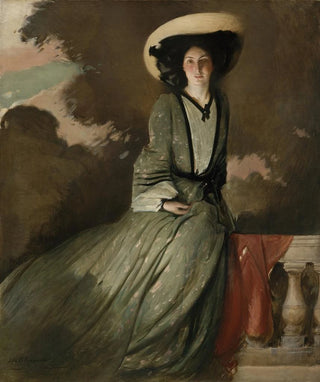Art print | Portrait of Mrs. John White Alexander - John White Alexander Source: Reproduction | Portrait de Mme John White Alexander - John White Alexander


View from behind

Frame (optional)
In the world of art, some works transcend the simple frame to become windows into the human soul. The "Portrait of Mrs. John White Alexander" by John White Alexander is one of those creations that captivates and fascinates. Created at the end of the 19th century, this piece does more than depict a female figure; it evokes psychological depth and intimacy that invite the viewer to contemplate the fleeting beauty of existence. Through delicate brushstrokes and carefully chosen color nuances, Alexander manages to immortalize not only the appearance of her model but also her essence, her character, and her inner world.
Style and uniqueness of the work
John White Alexander's style is distinguished by its approach that is both realistic and impressionistic. In this portrait, mastery of light and shadow creates an almost tangible atmosphere, where every detail, from the draping of the dress to the reflections in the hair, is treated with meticulous care that demonstrates a deep respect for the human figure. The artist uses a palette of soft colors that evoke gentleness and serenity, while infusing a vibrant life into the face of his muse. Mrs. Alexander's slightly tilted posture and her contemplative gaze, immersed in silent reflection, add a narrative dimension to the work. This portrait thus becomes a silent dialogue between the viewer and the subject, an invitation to explore the thoughts and emotions hidden behind this gaze.
The artist and his influence
John White Alexander, born in 1856, is often regarded as one of the great masters of American portraiture. Influenced by the artistic movements of his time, notably Impressionism, he developed a unique style that allowed him to stand out in the artistic landscape of the late 19th and early 20th centuries. His ability to capture light and play with textures inspired many contemporary and future artists. By painting figures from high society, Alexander also contributed to defining an aesthetic that reflects the aspirations and concerns of a rapidly changing era. His portraits, such as that of Mrs. John White Alexander, are not only testimonies of his talent but also reflections

Matte finish

View from behind

Frame (optional)
In the world of art, some works transcend the simple frame to become windows into the human soul. The "Portrait of Mrs. John White Alexander" by John White Alexander is one of those creations that captivates and fascinates. Created at the end of the 19th century, this piece does more than depict a female figure; it evokes psychological depth and intimacy that invite the viewer to contemplate the fleeting beauty of existence. Through delicate brushstrokes and carefully chosen color nuances, Alexander manages to immortalize not only the appearance of her model but also her essence, her character, and her inner world.
Style and uniqueness of the work
John White Alexander's style is distinguished by its approach that is both realistic and impressionistic. In this portrait, mastery of light and shadow creates an almost tangible atmosphere, where every detail, from the draping of the dress to the reflections in the hair, is treated with meticulous care that demonstrates a deep respect for the human figure. The artist uses a palette of soft colors that evoke gentleness and serenity, while infusing a vibrant life into the face of his muse. Mrs. Alexander's slightly tilted posture and her contemplative gaze, immersed in silent reflection, add a narrative dimension to the work. This portrait thus becomes a silent dialogue between the viewer and the subject, an invitation to explore the thoughts and emotions hidden behind this gaze.
The artist and his influence
John White Alexander, born in 1856, is often regarded as one of the great masters of American portraiture. Influenced by the artistic movements of his time, notably Impressionism, he developed a unique style that allowed him to stand out in the artistic landscape of the late 19th and early 20th centuries. His ability to capture light and play with textures inspired many contemporary and future artists. By painting figures from high society, Alexander also contributed to defining an aesthetic that reflects the aspirations and concerns of a rapidly changing era. His portraits, such as that of Mrs. John White Alexander, are not only testimonies of his talent but also reflections






